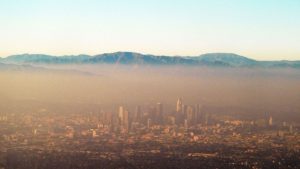Written by Bill Magavern, Policy Director for Coalition for Clean Air and originally posted in the Capital Weekly.
The bills (AB 398 and AB 617) that Gov. Jerry Brown signed on July 25 and 26 represent the culmination of years of debate in the Capitol over global warming and air quality. Now that those bills have become law, what have we learned?
Californians want to both clean up our local air and show the world how to reduce climate-changing emissions.
The Air Resources Board has been charged with the twin missions of relieving the air pollution that chokes much of the state and curbing the greenhouse gas emissions that warm the globe. It only makes sense to approach these goals in an integrated fashion, because both problems stem primarily from the same source – the burning of fossil fuels in our vehicles, power plants, buildings and factories. In order to achieve our standards for slashing both local air pollutants and greenhouse gas emissions, California needs to make substantial progress toward weaning ourselves off fossil fuels.
Environmental justice and air quality advocates for years have pointed out that emissions trading schemes, by allowing big polluters to buy their way out of reducing emissions, do not drive that de-carbonization process as well as direct regulation would. So people living downwind of large oil refineries, for example, do not benefit when the refinery owners purchase offsets from other states. Advocates have called for requiring such polluters to reduce their own on-site emissions rather than outsourcing those reductions to other jurisdictions.
This year, with the leadership of Assemblymember Christina Garcia, the Legislature and governor recognized that any reauthorization of the cap-and-trade program would have to be accompanied by measures to reduce the smog, particulate and toxic pollution that is making too many people sick in our communities. Garcia authored AB 617 to make what she called a “down payment” toward that end, and the bill was passed along with the cap-and-trade reauthorization, AB 398 (E. Garcia). Key provisions of AB 617 will: 1) require the big industrial polluters to use the cleanest available equipment; 2) expand air quality monitoring; 3) require regional air districts to reduce cumulative impacts of air pollution in the neighborhoods with the most toxic air; and 4) update the amounts of potential penalties for air pollution violations, which have been eroded by decades of inflation.
Two-thirds vote thresholds prompt special-interest giveaways.
Backers of cap-and-trade sought a 2/3 vote to immunize the program against future litigation, so the big polluters were able to use their hold over many legislators as an effective veto. The result is that AB 398 grants several goodies to special interests: the oil companies won restrictions on the air agencies from directly regulating refinery carbon dioxide emissions, manufacturers got an extension of sales tax exemptions, and several major industrial emitters were guaranteed free allocations of valuable pollution allowances. Finally, in order to bring some Republicans on board the administration and legislative leaders offered up ACA-1, which, if approved by voters on next year’s ballot, would add a new 2/3 requirement to approve the spending of climate investments in 2024, setting up opportunities for still more special-interest giveaways.
Legislators and agencies now should turn their attention to funding and implementation.
The biggest gap in AB 617 is that it has none of the funding that will be required to implement it. Money is needed for monitoring and planning, and most importantly for incentives to induce the owners of older, dirtier vehicles to scrap them and replace them with the cleanest available technology. Legislators also now can move to allocating the proceeds from auctions of carbon allowances. Because of last year’s AB 1550 (Gomez), which built on 2012’s SB 535 (De León), at least 25% of the funds must be spent in the most disadvantaged communities, with another 10% minimum reserved for low-income areas. These funds should be spent to fight pollution while providing transportation and energy services to underserved populations, through programs like zero-emission buses, rooftop solar, and urban tree planting.
In addition to overseeing these climate investments, the Air Resources Board needs to move quickly, along with the air districts, to implement AB 617 with rapid reductions in smog, particulates and air toxics in the most polluted neighborhoods. While taking the lead in policies that slow catastrophic climate change, California’s policy makers must also ensure that our residents can breathe easily.








